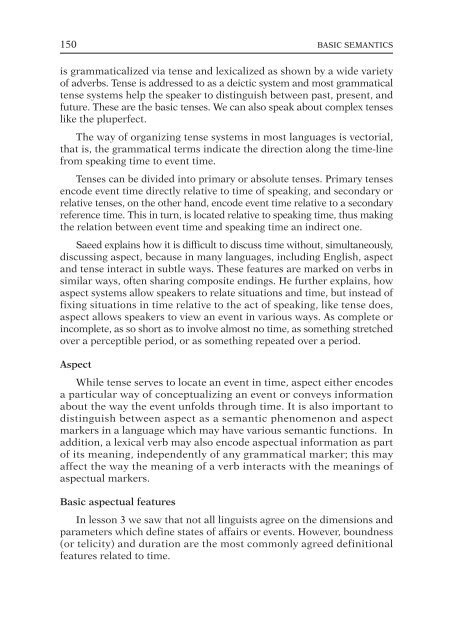Semantics
Create successful ePaper yourself
Turn your PDF publications into a flip-book with our unique Google optimized e-Paper software.
150 BASIC SEMANTICS<br />
is grammaticalized via tense and lexicalized as shown by a wide variety<br />
of adverbs. Tense is addressed to as a deictic system and most grammatical<br />
tense systems help the speaker to distinguish between past, present, and<br />
future. These are the basic tenses. We can also speak about complex tenses<br />
like the pluperfect.<br />
The way of organizing tense systems in most languages is vectorial,<br />
that is, the grammatical terms indicate the direction along the time-line<br />
from speaking time to event time.<br />
Tenses can be divided into primary or absolute tenses. Primary tenses<br />
encode event time directly relative to time of speaking, and secondary or<br />
relative tenses, on the other hand, encode event time relative to a secondary<br />
reference time. This in turn, is located relative to speaking time, thus making<br />
the relation between event time and speaking time an indirect one.<br />
Saeed explains how it is difficult to discuss time without, simultaneously,<br />
discussing aspect, because in many languages, including English, aspect<br />
and tense interact in subtle ways. These features are marked on verbs in<br />
similar ways, often sharing composite endings. He further explains, how<br />
aspect systems allow speakers to relate situations and time, but instead of<br />
fixing situations in time relative to the act of speaking, like tense does,<br />
aspect allows speakers to view an event in various ways. As complete or<br />
incomplete, as so short as to involve almost no time, as something stretched<br />
over a perceptible period, or as something repeated over a period.<br />
Aspect<br />
While tense serves to locate an event in time, aspect either encodes<br />
a particular way of conceptualizing an event or conveys information<br />
about the way the event unfolds through time. It is also important to<br />
distinguish between aspect as a semantic phenomenon and aspect<br />
markers in a language which may have various semantic functions. In<br />
addition, a lexical verb may also encode aspectual information as part<br />
of its meaning, independently of any grammatical marker; this may<br />
affect the way the meaning of a verb interacts with the meanings of<br />
aspectual markers.<br />
Basic aspectual features<br />
In lesson 3 we saw that not all linguists agree on the dimensions and<br />
parameters which define states of affairs or events. However, boundness<br />
(or telicity) and duration are the most commonly agreed definitional<br />
features related to time.



